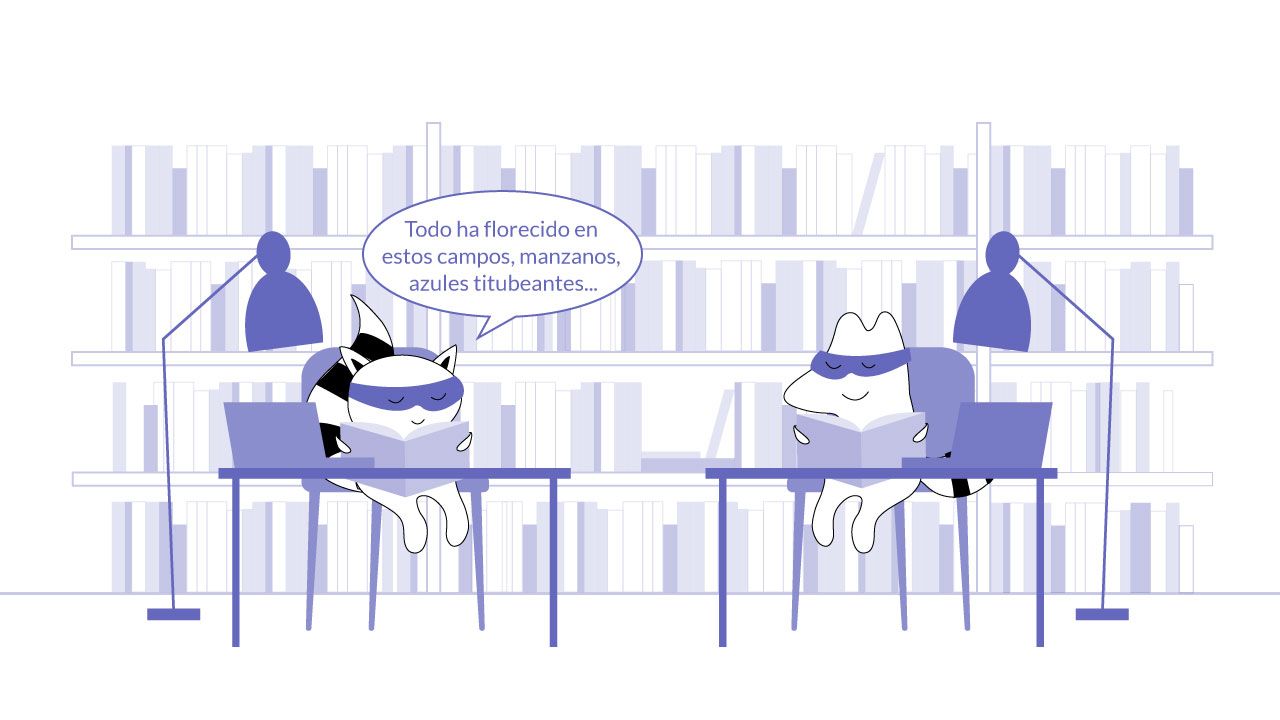
No matter what level you're starting at, reading books in Spanish can help improve your language skills. If you're a beginner, look for books that are specifically designed for new language learners. These books usually have a lot of pictures and use simple sentence structure to help you understand the story without a Spanish dictionary at hand.
As you become more proficient, you can start reading books that are intended for native Spanish speakers. Reading original texts in Spanish will help you improve your vocabulary and grammar skills.
And while reading a whole book in a foreign language might seem daunting at first, choosing the right Spanish language books is an excellent way to diversify your Spanish learning journey and start using Spanish in your everyday life.
If you're looking for some book recommendations, look no further – here are our favorite picks of the best fiction books for Spanish learners of all levels:
Learn Spanish with Langster
Don Quijote de la Mancha (Don Quixote)
by Miguel de Cervantes
Considered one of the greatest works of literature of all time, Miguel de Cervantes' Don Quijote de la Mancha is a must-read for any Spanish student. The book follows the adventures of the title character, a middle-aged man who sets out on a quest to become a wandering knight.
Don Quijote is known for its use of regional Spanish, so it's a great way to learn about different dialects. It's a long and difficult read, but it's also one of the most rewarding books you'll ever encounter. You'll laugh, cry, and be inspired by Cervantes' timeless tale.
La Casa de los Espíritus (The House of the Spirits)
by Isabel Allende
Isabel Allende's debut novel is a sweeping saga of love, loss, and magic. The story follows the lives of three generations of women in a Chilean family from the time of the country's independence to the military coup of 1973. All of these women are haunted by the spirits of their ancestors.
It's a great choice for intermediate and advanced readers, as it includes complex themes and language, but you'll be captivated by Isabel Allende's beautiful prose and the strength of her characters.
La Casa de Bernarda Alba (The House of Bernarda Alba)
by Federico García Lorca
Federico García Lorca's only play, La Casa de Bernarda Alba, is a tragedy set in rural post-war Spain. The story revolves around the titular character, a stern widow who rules her household with an iron fist. When Bernarda's youngest daughter attempts to break free from her mother's control, the disaster ensues.
This play is said to be a metaphor for society after the Spanish Civil War, making it a great choice for those interested in complex social issues and historical fiction. It's also a shorter read than some of the other options on this list.
García Lorca's powerful writing brings the characters to life, making this a gripping and moving read. The play is also a great introduction to Lorca's unique style of poetry.
La Casa en Mango Street (The House on Mango Street)
by Sandra Cisneros
A coming-of-age story told through a series of vignettes, La Casa en Mango Street is a modern classic. The book follows Esperanza, a young Latina girl growing up in the Chicago projects, as she comes to terms with her identity and her place in the world.
The book is written in simple, accessible Spanish, making it a great choice for beginners. But don't be fooled by its brevity – La Casa en Mango Street packs a powerful emotional punch.
El Amor en Los Tiempos Del Cólera (Love in the Time of Cholera)
by Gabriel García Márquez
This epic love story by Nobel Prize-winning author Gabriel García Márquez follows the lives of two lovers over the course of 50 years. It's a beautiful and tragic tale, told with García Márquez's trademark lyrical prose.
If you only started to learn Spanish, it might not be the best choice. However, if you're looking for a challenging read in Spanish, it’s the perfect choice for a Spanish book.

Cien Años de Soledad (One Hundred Years of Solitude)
by Gabriel García Márquez
Another masterpiece by Gabriel García Márquez, Cien años de soledad is the story of the Buendía family, told over the course of a century – it follows seven generations, chronicling their joys and sorrows. It's a sweeping epic that captures the essence of Latin American culture and history.
This is one of the most famous and widely read Spanish-language novels of all time and is perhaps the brightest example of magical realism in literature – a literary genre associated especially with Latin American authors. One of its most valuable characteristics is the presence of fantastic or mythical elements in otherwise realistic fiction.
While it's definitely not for beginners, you'll be rewarded with one of the most beautiful, unbelievable yet poignant stories you'll ever read if you're up for the challenge.
La Sombra del Viento (The Shadow of the Wind)
by Carlos Ruiz Zafón
Set in Barcelona in the years following the Spanish Civil War, La Sombra del Viento is a romantic thriller that will keep you guessing until the very end. The complex plot and richly-detailed setting make this a challenging read, but it's well worth the effort. You'll be rewarded with a fascinating glimpse into a dark period of Spanish history.
La Sombra del Viento is a great choice for readers of all levels. The story is complex, but the language is relatively simple. This makes it a great option for intermediate learners who want to diversify their language learning experience and expand their basic vocabulary.
Cuentos de la Selva (Jungle Tales)
by Horacio Quiroga
A collection of short stories set in the South American jungle that was originally written by Uruguayan author Horacio Quiroga for his children, Cuentos de la Selva is a great choice for intermediate Spanish learners. The stories are simple and accessible, but they're also filled with suspense, mystery, and even humor.
The tales consist mostly of short sentences which are easy to follow, but they're also filled with beautiful imagery and interesting characters. You'll learn new vocabulary while enjoying some of Quiroga's best-loved stories. You'll be captivated by his dark and atmospheric tales, and you'll also get a taste of the unique Spanish spoken in Uruguay, where the author was born.

Veinte Poemas de Amor Y Una Canción Desesperada (Twenty Love Poems and a Song of Despair)
by Pablo Neruda
One of the most famous collections of love poetry in the Spanish language crafted by Chilean poet Pablo Neruda, Veinte Poemas de Amor y una Canción Desesperada is perfect for intermediate-level learners. The poems range from sensual to desperate, and they offer a glimpse into the passion and turmoil of young love.
Wile the poems are simple and straightforward, they're also incredibly moving. You'll quickly fall in love with Neruda's beautiful words.
Travesuras De La Niña Mala Debolsillo (The Bad Girl)
by Mario Vargas Llosa
Mario Vargas Llosa is another Latin American Nobel-prize winner on our list, after Márquez and Neruda. His coming-of-age novel set in Peru, Travesuras de la Niña Mala follows the life of a conference interpreter and a young girl who rebels against her conservative upbringing.
Her story is one of self-discovery and sexual awakening, and it's told with humor, compassion, and insight. This is a great choice for readers who are looking for something a little different. It's also a good option for intermediate Spanish learners, as it includes some complex themes and language.

Rayuela (Punta de Lectura) (Hopscotch)
by Julio Cortázar
Rayuela is a novel unlike any other. It's experimental, playful, and at times, downright confusing. The story follows Horacio Oliveira, an Argentinian expat living between Paris and Buenos Aires, as he tries to make sense of his life and his relationships.
Cortázar's innovative use of language makes this a challenging but rewarding read. It's also a great choice for readers who are interested in avant-garde literature.
Como Agua Para Chocolate (Like Water for Chocolate)
by Laura Esquivel
A classic of magical realism, Como Agua Para Chocolate tells the story of Tita, a young woman who is forbidden to marry the man she loves. Tita expresses her feelings through her cooking, and as the novel progresses, her food starts to have mysterious and even magical effects on those who eat it.
Esquivel's beautiful prose makes this a captivating read, and the magical realism elements will transport you to another world. This is a great choice for intermediate and advanced readers looking for a dive into Spanish-speaking cultures and, more importantly, cuisine.
The Bottom Line

Whether you choose to read Spanish translations of the books you’re already familiar with or opt for an original text, exploring literature is the best possible way to improve your Spanish reading skills.
As you’ve probably noticed, Spanish literature is saturated with magic motives and mysteries, which makes it so engaging and unique. Moreover, when you read Spanish books, you get the chance to explore a variety of new cultures, traditions, and even cuisines, broadening your horizons.
If you love reading more than any other leisure activities, download our Langster app and start learning Spanish with stories! This way, you’ll be able to boost your Spanish skills while enjoying the process. Have fun!









